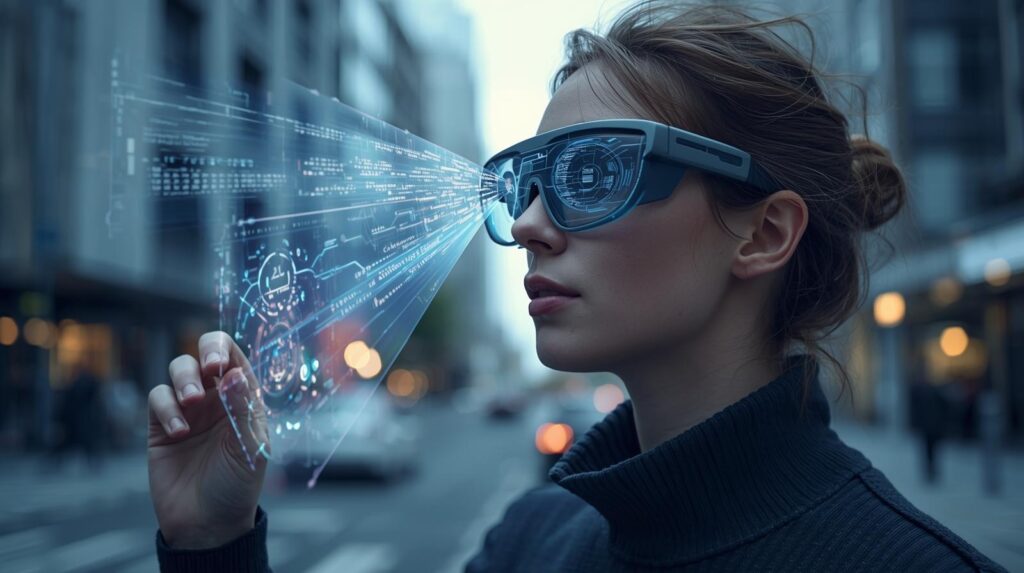The rapid evolution of technology continues to transform the way we interact with the world around us. Among the most promising developments in wearable technology are smart glasses. Once considered a futuristic concept, these devices are now on the cusp of widespread adoption, poised to revolutionize various aspects of our daily lives. But what exactly are smart glasses, and how will they shape the future?
Smart glasses are a form of wearable technology that incorporate augmented reality (AR) to overlay digital information onto the physical world. Unlike traditional eyewear, smart glasses are equipped with displays, sensors, and connectivity features that enable users to access information and interact with digital content seamlessly.
The Rise of Augmented Reality Glasses
Augmented reality glasses, a subset of smart glasses, enhance the user’s perception of reality by overlaying digital content onto their field of view. This technology has the potential to transform various industries, offering innovative solutions for both personal and professional use.
By integrating digital elements with the real world, AR glasses can enhance experiences in fields such as healthcare, education, retail, and entertainment. For instance, a surgeon could use AR glasses to access real-time data during an operation, while a teacher could provide interactive lessons that engage students in new ways.
The Role of Wearable Technology
Wearable technology, which includes devices like smartwatches and fitness trackers, has become increasingly popular in recent years. Smart glasses represent the next step in this evolution, offering a more immersive and hands-free experience. As wearables continue to gain traction, the demand for smart glasses is expected to grow, driven by advancements in miniaturization, battery life, and connectivity.
Practical Applications of Smart Glasses
The potential applications of smart glasses are vast and varied, spanning multiple sectors and use cases. Here, we explore some of the most promising areas where smart glasses could make a significant impact.
Enhancing Workplace Productivity
In the workplace, smart glasses can improve productivity by providing workers with real-time information and guidance. For example, in manufacturing, employees can use smart glasses to receive step-by-step assembly instructions, reducing the likelihood of errors and streamlining production processes. Additionally, remote collaboration becomes more efficient, as team members can share their perspectives through live video feeds and annotations.
Transforming Healthcare
The healthcare industry stands to benefit immensely from the adoption of smart glasses. Surgeons can leverage AR to access patient data and imaging during procedures, improving precision and outcomes. Moreover, medical professionals can use smart glasses for remote consultations and training, expanding access to specialized expertise and reducing the need for travel.
Revolutionizing Retail Experiences

In retail, smart glasses can enhance the shopping experience by providing customers with personalized recommendations and virtual try-on features. Shoppers can view product information and reviews in real-time, making informed purchasing decisions without the need for physical interaction. Retailers can also use smart glasses to optimize inventory management and streamline operations.
Enriching Education
Smart glasses have the potential to transform education by creating immersive learning environments. Teachers can use AR to illustrate complex concepts, making lessons more engaging and accessible. Students can participate in interactive simulations and virtual field trips, broadening their understanding of the world around them.
Challenges and Considerations
While the potential of smart glasses is undeniable, there are several challenges and considerations that must be addressed before they become mainstream.
Privacy and Security Concerns
As with any connected device, smart glasses raise privacy and security concerns. The ability to record and share visual data introduces potential risks related to surveillance and data breaches. Manufacturers must prioritize robust security measures and transparent privacy policies to mitigate these concerns and build trust among users.
User Experience and Design
For smart glasses to gain widespread acceptance, they must offer a seamless and comfortable user experience. This requires careful consideration of factors such as weight, battery life, and display quality. Moreover, the design should be aesthetically pleasing and unobtrusive, allowing users to wear the glasses comfortably for extended periods.
Cost and Accessibility
The cost of smart glasses remains a barrier to entry for many consumers and businesses. As technology advances and economies of scale are realized, prices are expected to decrease, making smart glasses more accessible to a wider audience. However, manufacturers must balance affordability with functionality to ensure that the devices deliver value to users.
The Future of Smart Glasses
The future of smart glasses is promising, with significant advancements on the horizon. As technology continues to evolve, we can expect to see improvements in areas such as display resolution, battery life, and connectivity. These advancements will pave the way for more sophisticated applications and greater adoption across industries.
Integrating with the Internet of Things (IoT)
The integration of smart glasses with the Internet of Things (IoT) will unlock new possibilities for connectivity and automation. By connecting to IoT devices, smart glasses can provide users with real-time data and control over their environment, enhancing convenience and efficiency.
Expanding into New Markets
As smart glasses become more affordable and user-friendly, they will likely expand into new markets and demographics. This could include applications in areas such as sports, tourism, and public safety, where real-time information and hands-free interaction offer distinct advantages.
Conclusion
Smart glasses represent a significant leap forward in wearable technology, offering a glimpse into a future where digital information seamlessly integrates with our daily lives. While challenges remain, the potential benefits of smart glasses are vast, spanning multiple industries and applications. As technology continues to advance, smart glasses will play an increasingly important role in shaping the way we interact with the world, driving innovation and transforming our experiences.
For Chief Technology Officers, Business Strategists, and Innovation Managers, staying informed about the developments in smart glasses and their implications is crucial. By understanding the opportunities and challenges associated with this technology, industry leaders can make informed decisions that align with their strategic goals and drive growth in an ever-evolving digital landscape.




